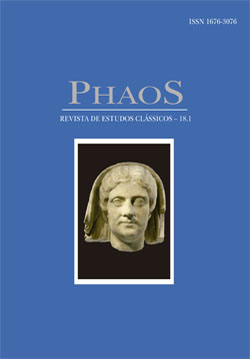Metaphor in Latin Descriptions of Reading and Meaning
Palavras-chave:
Latin metaphors. Metaphor theory. Reading and meaning.Resumo
In this article, metaphors for reading and meaning in Latin are considered from the perspective of conceptual metaphor theory. The focus is on (1) ascriptions of agency and personhood to inanimate entities such as words, texts, and books, and how the notions of (2) the container and (3) the path help to structure Latin descriptions of the relationship between words and ideas. The article closes with a case study of the noun intentio. By demonstrating the existence of these metaphors in Latin (building on previous scholarship), the article augments the historical and transcultural evidence for conceptual metaphor theory, further substantiates the theory’s explanatory value, and illustrates the dangers of taking English metaphors of meaning and intention inherited from Latin at face value.Referências
BEEKES, R. (2010). Etymological Dictionary of Greek. Leiden: Brill.
BLUM, H. (1969). Die antike Mnemotechnik. Hildesheim: Olms.
BORODITSKY, L. & RAMSCAR, M. (2002). The Roles of Body and Mind in Abstract Thought. Psychological Science n. 13, pp. 185-189.
CAVE, T. (2016). Thinking with Literature: towards a Cognitive Criticism. Oxford: Oxford University Press.
DANCYGIER, B.; SWEETSER, E. (2014). Figurative Language. Cambridge: Cambridge University Press.
ERNOUT, A. & MEILLET, A. (1959) Dictionnaire étymologique de la langue latine. Paris: Klinksieck.
FARRELL, J. (1999). The Ovidian Corpus: Poetic Body and Poetic Text. In: HARDIE, P.; BARCHIESI, A.; HINDS, S. (eds.). Ovidian Transformations: Essays on Ovid’s Metamorphoses and Its Reception. Cambridge: Cambridge University Press, pp. 127-141.
FARRELL, J. (2007). Horace’s Body, Horace’s Books. In: HEYWORTH, S. J. (ed.). Classical Constructions: Papers in Memory of Don Fowler, Classicist and Epicurean. Oxford: Oxford University Press, pp. 174-193.
FAUCONNIER, G. (1994 [1985]). Mental Spaces: Aspects of Meaning Construction in Natural Language. Cambridge: Cambridge University Press.
GITNER, A. (2014). Creeping Roots: Varro on Latin across Space and Time. Paper presented at the APA Annual Meeting, Chicago [seen in manuscript].
GRADY, J. (1998). The ‘Conduit’ Metaphor Revisited: A Reassessment of Metaphors for Communication. In: KOENIG, J.-P. (ed.). Discourse and Cognition: Bridging the Gap. Stanford (CA): CSLI Publications, pp. 1-16.
HEIDER, F.; SIMMEL, M. (1944). An Experimental Study of Apparent Behavior. The American Journal of Psychology, n. 57, pp. 243-259.
JOHNSON, M. (1987). The Body in the Mind: The Bodily Basis of Meaning, Imagination, and Reason. Chicago (IL): University of Chicago Press.
JOHNSON, W. A. (2010). Readers and Reading Culture in the High Roman Empire. Oxford: Oxford University Press.
KÖVECSES, ZS. (2015). Where Metaphors Come From: Reconsidering Context in Metaphor. Oxford: Oxford University Press.
KRZESZOWSKU, T. P. (1997). The Exculpation of the Conduit Metaphor. In: HICKEY, R.; PUPPEL, S. (eds.) Language History and Linguistic Modelling. A Festschrift for Jacek Fisiak on His 60th Birthday. Berlin: Mouton de Gruyter, pp. 1613-1620.
LAKOFF, G. (1987). Women Fire, and Dangerous Things: What Categories Reveal about the Mind, Chicago (IL): University of Chicago Press.
LAKOFF, G. (1999). Philosophy in the Flesh: The Embodied Mind and Its Challenge to Western Thought. New York (NY): Basic Books.
LAKOFF, G.; JOHNSON, M. (2003 [1980]). Metaphors We Live By. Chicago (IL): University of Chicago Press.
LANGACKER, R. W. (1987). Foundations of Cognitive Grammar, Vol. I: Theoretical Rerequisites. Stanford (CA): Stanford University Press.
LANGACKER, R. W. (2008). Cognitive Grammar: A Basic Introduction. Oxford: Oxford University Press.
MATLOCK, T.; BERGMANN, T. (2015). Fictive Motion. In. DABROWSKA, E.; DIVJAK, D. (eds.). Handbook of Cognitive Linguistics. Berlin: De Gruyter, pp. 546-562.
MCGLONE, M. S. & HARDING, J. L. (1998). Back (or Forward?) to the Future: The Role of Perspective in Temporal Language Comprehension. Journal of Experimental Psychology: Learning, Memory, and Cognition n. 24, pp. 1211-1223.
MOORE, K. E. (2014). The Spatial Language of Time: Metaphor, Metonymy, and Frames of Reference. Amsterdam: John Benjamins.
O’SULLIVAN, T. M. (2015). Augustan Literary Tours: Walking and Reading the City. In: ÖSTENBERG, I.; MALMBERG, S.; BJØRNEBYE, J. (eds.). The Moving City: Processions, Passages and Promenades in Ancient Rome. London: Bloomsbury, pp. 111-122.
REDDY, M. J. (1979). The Conduit Metaphor – A Case of Frame Conflict in Our Language about Language. In: ORTONY, A. (ed.) Metaphor and Thought. Cambridge: Cambridge University Press, pp. 284-324.
SHORT, W. M. (2008). Thinking Places, Placing Thoughts: Spatial Metaphors of Mental Activity in Roman Culture. Quaderni del Ramo d’Oro, n. 1, pp. 106-129.
SHORT, W. M. (2013a). Getting to the Truth: The ‘Wandering’ Metaphor of Mistakenness in Roman Culture. Arion, n. 21, pp. 139-168.
SHORT, W. M. (2013b). “Transmission” Accomplished? Latin’s Alimentary Metaphors of Communication. American Jounal of Philology, n. 134, pp. 247-275.
SHORT, W. M. (2016). Spatial Metaphors of Time in Roman Culture. Classical World, n. 109, pp. 381-412.
SMALL, J. P. (1999). Wax Tablets of the Mind: Cognitive Studies of Memory and Literacy in Classical Antiquity. London: Routledge.
TALMY, L. (2000). Toward a Cognitive Semantics, Vol. I: Concept Structuring Systems. Cambridge (MA): MIT Press.
WITTGENSTEIN, L. (2001 [1953]). Philosophical Investigations. 50th Anniversary Edition. London: Macmillan.
ZANKER, A. T. (2016). Greek and Latin Expressions of Meaning: The Classical Origins of a Modern Metaphor. Munich: Beck.
Downloads
Publicado
Edição
Seção
Licença
Ao se submeterem textos para a PhaoS, seus autores devem estar cientes de que, se aprovados para publicação, a revista terá sobre eles todos os direitos autorais pertinentes. Originais não serão devolvidos.

